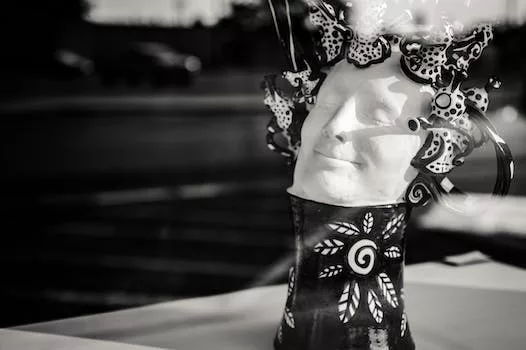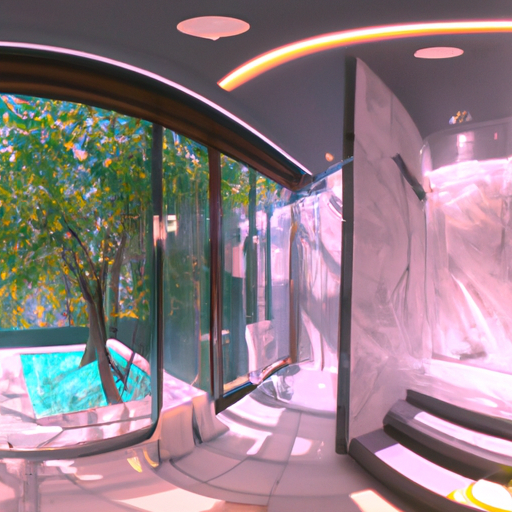Transforming Modern Complexes into Relaxing Sanctuaries: Design Tips for a Spa-Like Experience
In today’s fast-paced world, the need for relaxation and rejuvenation has become increasingly important. As a result, modern complexes are now looking to incorporate spa-like experiences into their design to provide residents and guests with a sanctuary where they can unwind and recharge. By incorporating elements of nature, soothing colors, and luxurious materials, designers can create spaces that evoke a sense of tranquility and promote overall well-being.
One of the key aspects of creating a spa-like experience in modern complexes is the incorporation of natural elements. This can be achieved through the use of natural materials such as wood, stone, and water features. For instance, wooden accents can be used in flooring, wall panels, and furniture to create a warm and inviting atmosphere. Stone can be incorporated in the form of countertops, wall cladding, and even as decorative elements in water features. The soothing sound of water can be introduced through indoor fountains, water walls, or even small tabletop features, which can help to create a calming ambiance and mask any unwanted noise from the surrounding environment.
Another important aspect of designing a spa-like experience is the use of color. Colors have a significant impact on our mood and emotions, and therefore, selecting the right color palette is crucial in creating a relaxing atmosphere. Soft, muted colors such as blues, greens, and earth tones are often associated with tranquility and can help to create a serene environment. These colors can be incorporated through paint, textiles, and decorative accessories. Additionally, the use of natural light can also play a significant role in creating a soothing atmosphere. Large windows, skylights, and glass doors can help to bring in natural light and create a connection with the outdoors, further enhancing the sense of relaxation.
Luxurious materials and finishes are also essential in creating a spa-like experience. High-quality textiles such as plush towels, soft linens, and cozy blankets can help to create a sense of comfort and indulgence. Additionally, incorporating materials such as marble, granite, and high-end ceramics can add a touch of elegance and sophistication to the space. These materials can be used in flooring, countertops, and wall cladding to create a luxurious and opulent atmosphere.
In addition to the visual aspects of design, it is also important to consider the functional aspects of creating a spa-like experience. This includes providing ample space for relaxation and incorporating elements that promote well-being. For instance, modern complexes can include dedicated spaces for meditation, yoga, or massage therapy. These spaces should be designed with comfort and relaxation in mind, incorporating soft lighting, comfortable seating, and soothing music. Additionally, amenities such as saunas, steam rooms, and hot tubs can also be included to provide residents and guests with a variety of options for relaxation and rejuvenation.
Finally, the incorporation of greenery and plants can also help to create a spa-like atmosphere in modern complexes. Plants not only add visual interest and color to space but also help to improve air quality and create a sense of connection with nature. Strategically placed plants, green walls, and even small indoor gardens can help to create a calming and soothing environment.
In conclusion, creating a spa-like experience in modern complexes requires a thoughtful approach to design that incorporates elements of nature, soothing colors, luxurious materials, and functional spaces that promote relaxation and well-being. By considering these aspects, designers can transform modern complexes into relaxing sanctuaries where residents and guests can escape the stresses of daily life and find a sense of balance and tranquility.
Elevating Wellness in Modern Living Spaces: Designing a Spa-Inspired Retreat

In today’s fast-paced world, the need for relaxation and rejuvenation has become increasingly important. As a result, modern living spaces are being designed to incorporate elements that promote wellness and tranquility. One such trend is the creation of spa-like experiences within residential and commercial complexes. By incorporating specific design elements, architects and interior designers can create spaces that not only look and feel luxurious but also provide a sanctuary for residents and visitors to unwind and recharge.
One of the key aspects of designing a spa-inspired retreat is the use of natural materials. Materials such as wood, stone, and bamboo can be used in various ways to create a sense of warmth and connection to nature. For instance, wooden flooring or wall panels can be used to create a cozy atmosphere, while stone accents can be incorporated into bathroom designs to evoke the feeling of a natural hot spring. Bamboo can be used for furniture and accessories, adding a touch of Zen to the space.
Another important element in creating a spa-like experience is the use of water features. The sound of flowing water has a calming effect on the mind and can help to create a serene atmosphere. Indoor water features such as fountains, water walls, or even small tabletop water features can be incorporated into the design to bring the soothing sounds of nature indoors. In addition, the use of water in the form of steam rooms, saunas, and hydrotherapy pools can provide therapeutic benefits and enhance the overall spa experience.
Lighting plays a crucial role in setting the mood and ambiance of a space. In a spa-inspired retreat, the goal is to create a soothing and calming environment. This can be achieved by using soft, warm lighting that mimics the natural glow of candlelight. Dimmable lights and smart lighting systems can be used to adjust the brightness and color temperature of the space, allowing residents to create their desired atmosphere. Additionally, incorporating natural light through large windows or skylights can help to create a sense of openness and connection to the outdoors.
Aromatherapy is another aspect that can be incorporated into the design of a spa-like space. The use of essential oils and diffusers can help to create a calming and relaxing atmosphere, while also providing various health benefits. Designers can consider incorporating built-in diffusers or scent delivery systems into the space, allowing residents to customize the aroma of their environment.
Lastly, the layout and flow of the space should be carefully considered to promote relaxation and rejuvenation. Open floor plans and minimalist design principles can help to create a sense of spaciousness and tranquility. Designers should also consider incorporating dedicated areas for relaxation and meditation, such as cozy nooks or window seats that provide a quiet space for reflection.
In conclusion, creating a spa-like experience in modern complexes requires a thoughtful approach to design that incorporates natural materials, water features, lighting, aromatherapy, and a well-planned layout. By focusing on these elements, architects and interior designers can elevate the wellness factor in modern living spaces, providing residents with a sanctuary where they can escape the stresses of daily life and recharge their mind, body, and spirit. As the demand for wellness-focused living spaces continues to grow, the integration of spa-inspired design elements will become increasingly important in shaping the future of residential and commercial complexes.
The Art of Zen Design: Creating a Spa-Like Ambiance in Contemporary Complexes
The art of Zen design is a concept that has been gaining popularity in recent years, particularly in the realm of modern complexes. This design philosophy is centered around the idea of creating a serene, tranquil environment that promotes relaxation and well-being. By incorporating elements of Zen design into contemporary complexes, architects and designers can create a spa-like ambiance that appeals to residents and visitors alike. In this article, we will explore the key principles of Zen design and discuss how they can be applied to create a spa-like experience in modern complexes.
One of the fundamental principles of Zen design is the concept of simplicity. This can be achieved through the use of clean lines, minimal ornamentation, and a neutral color palette. By incorporating these elements into the design of a modern complex, architects and designers can create a space that feels calm and uncluttered. This sense of simplicity can be further enhanced by incorporating natural materials, such as wood, stone, and bamboo, which can help to create a connection with the natural world and promote a sense of tranquility.
Another important aspect of Zen design is the idea of balance and harmony. This can be achieved through the careful arrangement of architectural elements, furniture, and decorative items. By creating a sense of symmetry and proportion in the design of a modern complex, architects and designers can help to promote a feeling of balance and harmony that is conducive to relaxation and well-being. This can be particularly important in communal spaces, such as lobbies, lounges, and pool areas, where residents and visitors may gather to unwind and socialize.
In addition to simplicity and balance, Zen design also places a strong emphasis on the importance of natural light. By incorporating large windows, skylights, and other sources of natural light into the design of a modern complex, architects and designers can help to create a bright, airy atmosphere that feels inviting and rejuvenating. This can be particularly beneficial in spaces such as fitness centers and yoga studios, where natural light can help to enhance the overall experience and promote a sense of well-being.
Water features are another key element of Zen design that can be used to create a spa-like ambiance in modern complexes. The sound of flowing water can have a calming effect on the mind and can help to create a sense of tranquility and relaxation. By incorporating water features such as fountains, water walls, or even small ponds into the design of a modern complex, architects and designers can help to create a soothing atmosphere that is reminiscent of a luxury spa.
Finally, the incorporation of greenery and natural elements is essential in creating a Zen-inspired environment. By incorporating plants, trees, and other natural elements into the design of a modern complex, architects and designers can help to create a sense of connection with nature and promote a sense of well-being. This can be particularly important in urban environments, where access to green spaces may be limited.
In conclusion, the art of Zen design offers a wealth of inspiration for architects and designers looking to create a spa-like ambiance in contemporary complexes. By incorporating elements of simplicity, balance, natural light, water features, and greenery, it is possible to create a serene, tranquil environment that promotes relaxation and well-being. As the demand for wellness-focused living spaces continues to grow, the principles of Zen design are likely to play an increasingly important role in shaping the future of modern complex design.
Q&A
Question 1: What are the key design elements to consider when creating a spa-like experience in modern complexes?
Answer 1: The key design elements to consider when creating a spa-like experience in modern complexes include incorporating natural materials, ensuring ample natural light, creating a seamless indoor-outdoor connection, incorporating water features, using calming colors and textures, and designing spaces for relaxation and rejuvenation, such as saunas, steam rooms, and massage areas.
Question 2: How can lighting and color schemes contribute to a spa-like atmosphere in modern complexes?
Answer 2: Lighting and color schemes play a crucial role in creating a spa-like atmosphere in modern complexes. Soft, warm, and natural lighting helps to create a calming and relaxing environment. Color schemes should be neutral and soothing, with shades of white, beige, gray, and soft pastels, which promote relaxation and tranquility.
Question 3: What types of materials and finishes should be used to create a luxurious and spa-like feel in modern complexes?
Answer 3: To create a luxurious and spa-like feel in modern complexes, use natural materials and finishes such as wood, stone, and marble. These materials evoke a sense of warmth and connection to nature. Additionally, incorporate soft textiles like plush towels, robes, and linens, as well as high-quality fixtures and fittings made from materials like brushed nickel, copper, or brass to enhance the overall sense of luxury and comfort.
Conclusion
In conclusion, creating a spa-like experience in modern complexes through design involves incorporating elements of relaxation, tranquility, and luxury. This can be achieved by using natural materials, soothing color schemes, and incorporating water features, greenery, and ambient lighting. Additionally, providing dedicated spaces for various wellness activities, ensuring privacy, and focusing on user experience will contribute to a holistic spa-like atmosphere that promotes well-being and rejuvenation for residents and visitors alike.


